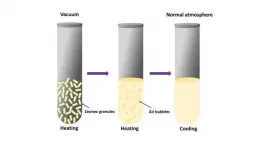Researchers develop tiny sensor for measuring subtle pressure changes inside the body
Advanced polymer optical sensor is designed to be implanted for long-term health monitoring
2021-02-17
(Press-News.org) WASHINGTON -- Researchers have developed an extremely sensitive miniaturized optical fiber sensor that could one day be used to measure small pressure changes in the body.
"Our new pressure sensor was designed for medical applications and overcomes many of the issues of using silica-based fibers," said research team leader Hwa-Yaw Tam from The Hong Kong Polytechnic University. "It is sensitive enough to measure pressure inside lungs while breathing, which changes by just a few kilopascals."
The researchers describe their new optical fiber sensor in The Optical Society (OSA) journal Optics Letters. The sensor, which is based on a fiber Bragg grating (FBG) inscribed into a fiber made from a new polymer called Zeonex, was able to detect pressure changes of just 2 kilopascals.
"Our FBG sensor could be used in various medical applications because, in addition to its biocompatibility, the fiber is chemically inert and also not sensitive to moisture," said Tam. "Our ultimate objective is to use these types of sensors to monitor various parameters -- including pressure, temperature and strain -- inside animals and people."
Making a polymer sensor
Many fiber optic sensors are based on FBGs, tiny periodic microstructures that can be inscribed onto a fiber. When pressure rises the fiber stretches slightly, increasing the grating period in a way that changes its refractive index and shifts the light output toward the red end of the spectrum. Similarly, a decrease in pressure produces a blue shift.
Making an FBG sensor from a traditional silica optical fiber is not ideal for medical applications, especially those involving long-term use in the body, because these fibers exhibit a relatively high stiffness and can be brittle. FBGs embedded in silica fibers also have limited sensitivity to small pressure changes because the material does not stretch and contract very easily. Although polymer optical fibers have been developed, they tend to absorb water -- which can affect measurements -- and are not very easy to inscribe with an FBG.
To overcome these hurdles, the researchers turned to the advanced polymer Zeonex. This new material is not only chemically inert and works well in the aqueous environments like those found in the body, but also exhibits a higher light shift in response to a pressure change compared to silica fibers. Although substances called dopants are often used to make materials with different refractive indexes for the inner core and outside cladding of fibers, the researchers simplified the fabrication process by using different grades of Zeonex to make a single-material fiber.
"Eliminating the use of dopants allows the optical fibers to be fabricated with good reproducibility," said Tam. "We were able to use an excimer laser to easily inscribe the FBG and to add a side hole that runs parallel to the core. The side hole enhanced the pressure measurement sensitivity and significantly reduced lag, therefore providing better measurement accuracy."
High-resolution, reproducible readings
To demonstrate the new sensor, the researchers compared its performance with a traditional polymer-based sensor of a similar design. The sensors were placed inside a chamber, where the pressure was manually increased and decreased step by step above and below the atmospheric pressure. The corresponding light shift was monitored in real time for both sensors.
They found that the Zeonex-based sensors with the side-hole design produced a response that was linear, repeatable and had negligible lag or errors. The tests showed that the sensor can be used for low pressure measurement up to 50 kilopascals above or below atmospheric pressure with a resolution of 2.0 kilopascals. The sensitivity of the pressure measurement is increased by 80% compared to a traditional polymer-based sensor.
"The pressure sensor is most useful in conditions where the change in pressure is in the order of few kilopascals above and below the atmospheric pressure," said Tam. "It could be useful for low pressure sensing in medical and high-altitude environments as well as for detecting pressure changes in gaseous containers."
The researchers are now working to further reduce the sensor's response time, which is currently few tens of seconds. They also want to expand the sensor to measure other physical and chemical parameters such as pH and to functionalize the probe so that it can detect the pressure of a particular gas.
INFORMATION:
Paper: J. N. Dash, X. Cheng, H.-Y. Tam, "Low gas pressure sensor based on polymer optical fiber grating," Opt. Lett., 46, 5, 933-936 (2021).
DOI: https://doi.org/10.1364/OL.418096.
About Optics Letters
Optics Letters offers rapid dissemination of new results in all areas of optical science with short, original, peer-reviewed communications. Optics Letters accepts papers that are noteworthy to a substantial part of the optics community. Published by The Optical Society and led by Editor-in-Chief Miguel Alonso, Institut Fresnel, École Centrale de Marseille and Aix-Marseille Université, France, University of Rochester, USA. Optics Letters is available online at OSA Publishing.
About The Optical Society
Founded in 1916, The Optical Society (OSA) is the leading professional organization for scientists, engineers, students and business leaders who fuel discoveries, shape real-life applications and accelerate achievements in the science of light. Through world-renowned publications, meetings and membership initiatives, OSA provides quality research, inspired interactions and dedicated resources for its extensive global network of optics and photonics experts. For more information, visit osa.org.
Media Contact:
mediarelations@osa.org
[Attachments] See images for this press release:

ELSE PRESS RELEASES FROM THIS DATE:
2021-02-17
A new X-ray imaging scanner to help surgeons performing breast tumour removal surgery has been developed by UCL experts.
Most breast cancer operations are what are known as conserving surgeries, which remove the cancerous tumour rather than the whole breast. Second operations are often required if the margins (edges) of the extracted tissue are found to not be clear of cancer.
Researchers at UCL, Queen Mary University of London, Barts Health NHS Trust and Nikon used a new approach to x-ray imaging which allows surgeons to assess extracted tissue intraoperatively, or during the initial surgery, giving 2.5 times better detection of diseased tissue in the margins than with standard ...
2021-02-17
Polyisobutenyl succinic anhydrides (PIBSAs) are important for the auto industry because of their wide use in lubricant and fuel formulations. Their synthesis, however, requires high temperatures and, therefore, higher cost.
Adding a Lewis acid--a substance that can accept a pair of electrons--as a catalyst makes the PIBSA formation more efficient. But which Lewis acid? Despite the importance of PIBSAs in the industrial space, an easy way to screen these catalysts and predict their performance hasn't yet been developed.
New research led by the Computer-Aided Nano and Energy Lab (CANELa) at the University of Pittsburgh Swanson School of Engineering, in collaboration with the ...
2021-02-17
Wearable sleep tracking devices - from Fitbit to Apple Watch to never-heard-of brands stashed away in the electronics clearance bin - have infiltrated the market at a rapid pace in recent years.
And like any consumer products, not all sleep trackers are created equal, according to West Virginia University neuroscientists.
Prompted by a lack of independent, third-party evaluations of these devices, a research team led by Joshua Hagen, director of the Human Performance Innovation Center at the WVU Rockefeller Neuroscience Institute, tested the efficacy of eight commercial sleep trackers.
Fitbit and Oura came out on top in measuring total sleep time, total wake ...
2021-02-17
SAN ANTONIO -- Patients should be assessed for frailty before having many types of surgery, even if the surgery is considered low risk, a review of two national patient databases shows.
Frailty is a clinical syndrome marked by slow walking speed, weak grip, poor balance, exhaustion and low physical activity. It is an important risk factor for death after surgery, although the association between frailty and mortality across surgical specialties is not well understood.
The study, conducted by faculty at multiple institutions including The University of Texas Health Science Center at San Antonio (UT Health San Antonio), mined patient data from the Veterans Affairs (VA) Surgical Quality Improvement Program and the American College of Surgeons (ACS) National Surgical Quality ...
2021-02-17
The millions of people affected by 2020's record-breaking and deadly fires can attest to the fact that wildfire hazards are increasing across western North America.
Both climate change and forest management have been blamed, but the relative influence of these drivers is still heavily debated. The results of a recent study show that in some ecosystems, human-caused climate change is the predominant factor; in other places, the trend can also be attributed to a century of fire suppression that has produced dense, unhealthy forests.
Over the past decade, fire scientists have made major progress in understanding climate-fire relationships at large scales, such as across western North America. But a new paper published in the journal Environmental Research ...
2021-02-17
ROCHESTER, Minn. -- Mayo Clinic researchers have developed a novel proton therapy technique to more specifically target cancer cells that resist other forms of treatment. The technique is called LEAP, an acronym for "biologically enhanced particle therapy." The findings are published today in Cancer Research, the journal of the American Association for Cancer Research.
"The human body receives tens of thousands of DNA lesions per day from a variety of internal and external sources," says Robert Mutter, M.D., a radiation oncologist at Mayo Clinic and co-principal investigator of the study." Therefore, cells have evolved complex repair pathways to efficiently repair damaged DNA. Defects in these repair pathways ...
2021-02-17
With the seemingly unstoppable advancement in the fields of miniaturization and materials science, all sorts of electronic devices have emerged to help us lead easier and healthier lives. Wearable sensors fall in this category, and they have received much attention lately as useful tools to monitor a person's health in real time. Many such sensors operate by quantifying biomarkers, that is, measurable indicators that reflect one's health condition. Widely used biomarkers are heartrate and body temperature, which can be monitored continuously with relative ease. On the contrary, ...
2021-02-17
Holograms are everywhere, from driver's licenses to credit cards to product packaging. And now, edible holograms could someday enhance foods. Researchers reporting in ACS Nano have developed a laser-based method to print nanostructured holograms on dried corn syrup films. The edible holograms could also be used to ensure food safety, label a product or indicate sugar content, the researchers say.
Most holograms are imprinted with lasers onto metal surfaces, such as aluminum, but the materials aren't edible. For foods, holograms made with nanoparticles have been proposed, but the tiny particles can generate reactive oxygen species, which might be harmful for people to eat. In a different approach, food scientists have ...
2021-02-17
ROCHESTER, Minn. -- A new study by Mayo Clinic researchers has identified that a chromosome instability gene, USP24, is frequently missing in pediatric patients with neuroblastoma, an aggressive form of childhood cancer. The finding provides important insight into the development of this disease. The study is published in Cancer Research, the journal of the American Association for Cancer Research.
"Neuroblastoma is a highly aggressive cancer that nearly exclusively affects young children," says Paul Galardy, M.D., a pediatric hematologist and oncologist at Mayo Clinic. Despite the use of multiple treatment approaches, Dr. Galardy says many children die of this disease every year.
To identify new ...
2021-02-17
A mutation in the spike protein of SARS-CoV-2--one of several genetic mutations in the concerning variants that have emerged in the United Kingdom, South Africa, and Brazil--makes the virus up to eight times more infectious in human cells than the initial virus that originated in China, according to research published in the journal END ...
LAST 30 PRESS RELEASES:
[Press-News.org] Researchers develop tiny sensor for measuring subtle pressure changes inside the body
Advanced polymer optical sensor is designed to be implanted for long-term health monitoring





